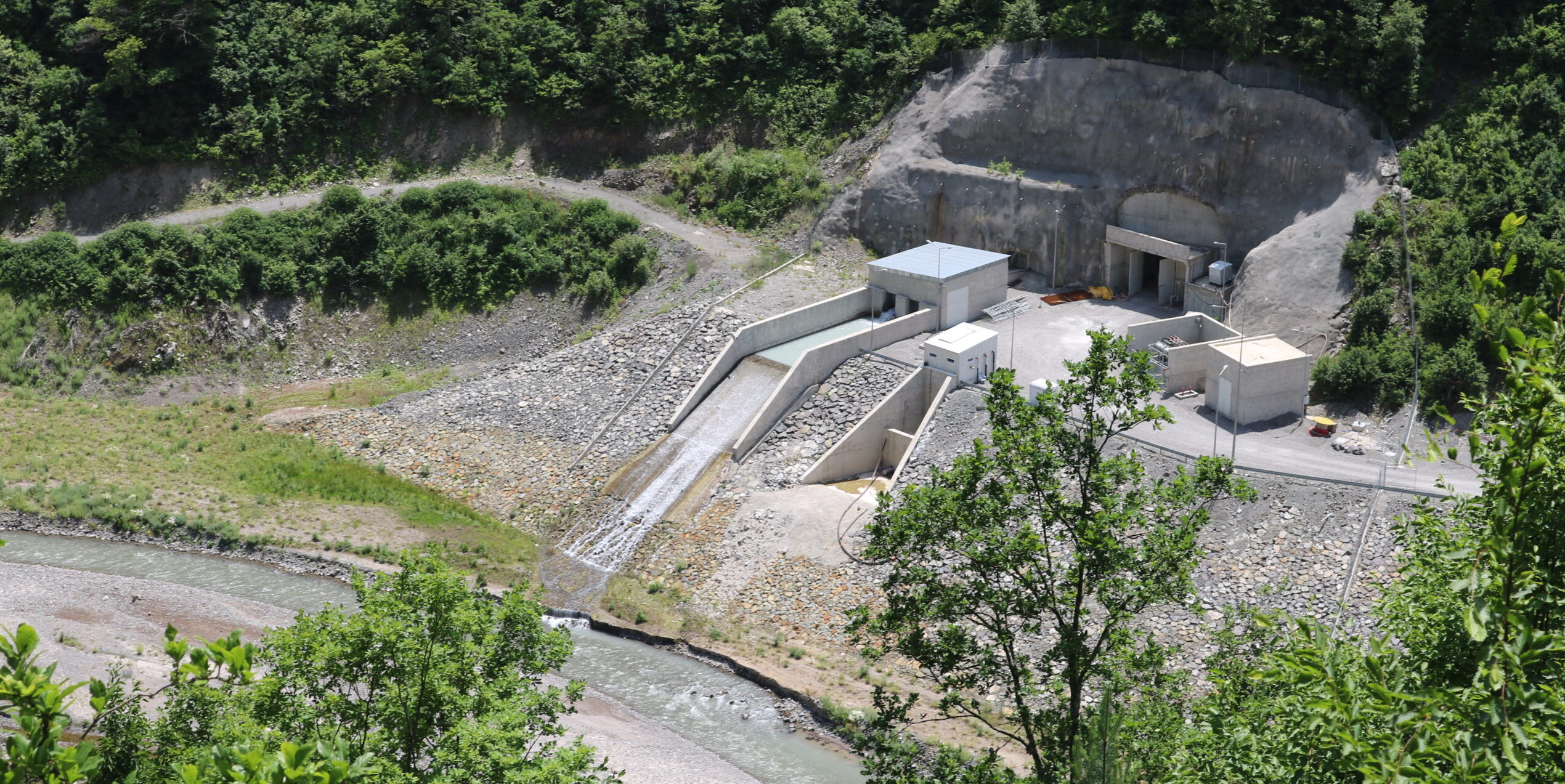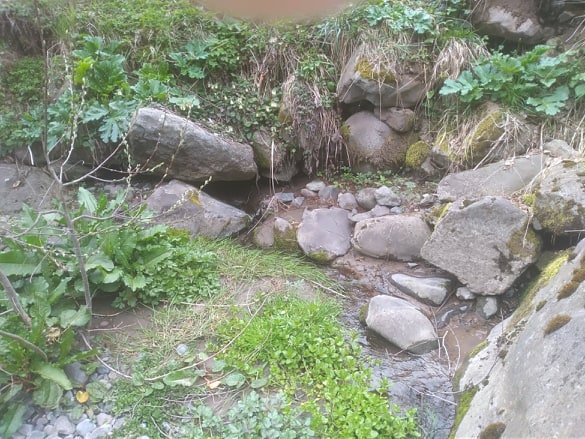Georgia’s Shuakhevi hydropower plant (HPP), which once promised to bring energy independence to the country but collapsed soon after becoming operational in 2017, has come back to life. But its return has not been welcome.
Rusudan Panozishvili, Media and Community Coordinator in Georgia | 17 April 2020

Shuakhevi hydropower plant, July 2019
Locals have started raising concerns that the malfunction of the plant’s derivation tunnels, which pass through their villages, has already caused massive water leakages and is ‘dangerous for life’ – particularly for those living in landslide risk areas.
In March 2020, India’s power company Tata Power (one of the shareholders in Shuakhevi) announced ‘the start of commercial operation of the 178 MW Shuakhevi Hydro Power Project (Shuakhevi HPP) located in southwest Georgia’. It is one of the largest of the 140 hydropower plant projects currently under development in Georgia.
It is also among the most controversial power plants, mainly because of the geological threats it poses to local communities. CEE Bankwatch Network raised a red flag about this in 2019.
Since its construction commenced in 2013, the Shuakhevi project has been met with a number of demonstrations, lawsuits and complaints to the international financial institutions (IFIs) funding the HPP as the affected communities tried to find solutions for their cracked houses, decreased crops, disappeared drinking water and water leakages. They complain that these are the direct consequences of the construction.
The people of Shuakhevi have been living with the constant fear of deadly landslides, which are a likely risk in the area because of its geological structure and the type of heavy construction being undertaken there. These protests, however, did not stop Shuakhevi’s promoters from launching the project in 2017. But after just two months, Shuakhevi failed: the tunnels of the USD 420 million hydro power plant collapsed at eight different spots.

Three international financial institutions, the Asian Development Bank, European Bank for Reconstruction and Development and International Financial Institution, are among the funders of Shuakhevi HPP. The IFC is also a shareholder in Adjaristsqali Georgia LLC (AGL), the special purpose vehicle established for developing hydropower in this region, along with Tata Power and Clean Energy Invest (Norway).
‘It is a well-known fact that we live in a landslide risk area. These springs of water which started leaking about a month ago here are dangerous, as it could move the land and one day all of us might be taken down to the river and we might not survive, like other villages once could not’, said Madona Tavdgiridze, a local of the village Golkhanauri. She is referring to the two villages in the municipality that were taken down by a landslide decades ago.
The official website of the Georgian Electricity Market Operator states that Shuakhevi HPP has already been operating since the beginning of March of 2020. This time coincides with when the communities of Golkhanauri and Makhalakidzeebi recall the reappearance of massive amounts of water less than a kilometer from their houses.
Golkhanauri is situated in the municipality of Shuakhevi, right below the plant’s 17.8 km long tunnel, one of the three of its water diverting structures. Years ago, after the drilling for tunnel construction kicked off, several water springs disappeared, including drinking water springs in both villages.
‘Later, when the plant became operational and derived water through the tunnel, some areas of the village were full of leaking water. Then the water outflows disappeared soon after the plant was shut down 3 years ago’, said Tavdgiridze. This is why she and her villagers believe Shuakhevi HPP is the reason for the water-saturated lands which they have to live on and which they fear are a threat to their lives.
Another water leakage showed up in the village of Makhalakidzeebi as well. Locals said the water is leaking exactly along the area where the tunnel passes, from 100 to 150 metres from the settlement. In addition to the cracks in the walls of village houses and falling stones, which have continued since the explosions for tunnel construction near the village, locals fear the water leakage could cause erosion, or even a landslide ‘that will result in something bad’.

Makhalakidzeebi has been part of a mediation process with the Shuakhevi HPP company since 2018. The process is facilitated by the accountability mechanisms of the EBRD and IFC, in order to solve problems between the community and the company. Its results have yet to be disclosed.
The company itself has not engaged most of the project-affected villages in a dialogue about the fate of the project, its impacts and measures it has taken to address people’s fears. Instead, information has mostly been available from locals working on the reconstruction of the tunnels, but not from official and reliable sources.
The company carried out a number of Corporate Social Responsibility projects before the tunnel collapse in 2017 and has continued with support for some educational activities in villages. However, these are a poor substitute for transparency and public consultations on issues, such as damage to subsistence agriculture and geological risks, that keep people awake at night.
The villages are not the only places where Shuakhevi’s renewed operations have raised questions. Georgian media outlet Batumelebi recently spread a video taken on 10 April at the Didachara dam and reservoir of the Shuakhevi HPP, which shows a flaw that is allowing a significant amount of water to leak out of this 52 metre high concrete dam. Adjaristsqali Georgia replied that ‘such leakages are common’ due to temperature changes and the company is ‘working to fix it’.
‘The local communities have been complaining about project impacts for years, as the construction process of Shuakhevi hydro showed it creates a clear threat for their safety and livelihood. Since its failure, the company has spent enormous money to fix the project; however, till now no responses have been given to communities who have experienced damages’, Manana Kochladze, representative of CEE Bankwatch Network said. ‘Now the project is supposed to become fully operational, and fears among communities are back. At the end of the day, nobody takes responsibility for the failure of the project in 2017, no remedies have been put in place to address the concerns of the communities’.
Although the collapse of the power plant tunnels in 2017 was later officially attributed by Adjaristsqali Georgia to ‘unpredictable geological processes’, the company’s official website does not disclose any updated environmental or geological studies conducted after its failure.
Locals of Golkhanauri said representatives of the company have been to the spot and seen the soaked lands at the tunnel areas but have not yet officially confirmed its cause. In 2019, CEO of Adjaristsqali Georgia Prashant Joshi told Georgian independent outlet Batumelebi that the company does not take responsibility for the problems in Golkhanauri.
The company stated in its press release published on 30 March: ‘AGL will be soon commissioning the 9 MW Skhalta Hydro Power project which is also a component of the overall Shuakhevi Project scheme’.
In full swing ahead but with a daunting past, Shuakhevi still has to prove that it will not fail again. After a decade of controversial history, with three influential financial institutions involved, Shuakhevi remains a project that has put communities living in landslide areas at risk, with a lack of water and ability to participate in the agricultural activities that give them their livelihood, and without a clear answer about who is, or will be, responsible for their damage.
Never miss an update
We expose the risks of international public finance and bring critical updates from the ground – straight to your inbox.
Institution: EBRD
Theme: hydropower plant
Location: Georgia
Project: Shuakhevi
Tags: Georgia | hydropower
